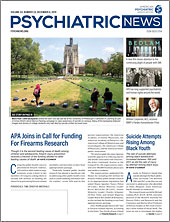The mortality numbers related to tobacco use are startling: According to the Centers for Disease Control and Prevention, cigarette smoking is responsible for more than 480,000 deaths a year—or about 1,300 deaths a day—in the United States. Globally, tobacco use causes more deaths each year than malaria, tuberculosis, and HIV/AIDS combined.
Yet, these deaths rarely receive much attention, said addiction specialist Michael Brus, M.D., during the session “The Deadliest Drug Epidemic: How Psychiatrists and the Media Miss the Boat on Tobacco Addiction, and What to Do About It” at IPS: The Mental Health Services Conference in October. Brus is a clinical instructor of psychiatry at the Icahn School of Medicine at Mount Sinai.
Brus said he believes there are two main reasons the media underreport on deaths from tobacco use disorder: tobacco use has always been a legal activity, and most deaths from tobacco occur in older adults from complications related to smoking. “People don’t consider smoking as drug use,” Brus said.
It’s not just the media that underplay the risk of tobacco use, Brus added. Despite the higher rates of smoking by people with mental illness compared with those without mental illness, only a quarter of facilities that treat patients with substance use disorders in the United States offer nicotine replacement therapy or medication treatment, and two-thirds allow tobacco use on their grounds, Brus explained. Brus called for psychiatrists to do more to address tobacco use in this population.
“Why do 2 out of 3 substance use facilities allow tobacco on campus? Why do only about a quarter of them offer nicotine replacement therapy?” he asked the audience. “And, why do so many psychiatrists ignore tobacco-related research data?”
Brus noted that last question was a reference to a landmark 2016 study known as EAGLES, which examined the safety and efficacy of varenicline and bupropion with nicotine patch and placebo in smokers with and without psychiatric disorders. The study included over 8,000 adults who smoked; 4,000 of the participants also had a psychiatric illness.
The study found that varenicline (Chantix) was superior to both bupropion and the nicotine patch at helping smokers become abstinent when combined with behavioral counseling; in addition, bupropion and the patch along with counseling were superior to counseling plus placebo. Smokers who took varenicline or bupropion (even those who had been diagnosed with a psychiatric illness) were no more likely to experience psychiatric side effects, such as depression, anxiety, or suicidal thoughts, than those taking placebo or using a nicotine patch compared with placebo.
This study convinced the Food and Drug Administration to remove a black-box warning that varenicline might increase the risk of suicidal thoughts. Yet in the three years since, the number of varenicline prescriptions has risen only gradually, suggesting the research evidence has not made a big clinical impact.
To help patients successfully quit tobacco use, presenter Jill Williams, M.D., director of the Division of Addiction Psychiatry at the Rutgers University-Robert Wood Johnson Medical School, told the audience that psychiatrists should regularly ask patients about their tobacco use, and if they do use tobacco, advise patients on the risks of such use and refer them to treatment such as behavioral counseling. “Half of the time, we are not even asking patients about tobacco at mental health facilities, let alone treating them,” she said. “Ask, advise, refer; we can all do that.”
Psychiatrists should also consider offering treatment themselves. “We should develop a co-occurring disorders treatment plan that includes tobacco use disorder for all smokers,” Williams said. Not every psychiatrist may have the time to provide behavioral counseling for smoking or feel comfortable doing so, but they can offer pharmacotherapy, she said. The most effective options are varenicline or combination nicotine replacement (the use of both a long-acting patch and rapid-acting lozenge or gum); either of these options should be considered a first-line option. The current data are inconsistent as to whether combining varenicline and nicotine replacement is superior to either individual approach, Williams added.
Even if patients are not interested in quitting, psychiatrists should still consider prescribing these therapies, Williams noted. “These medications help lower nicotine dependence and lessen withdrawal symptoms, so giving patients these options can be seen as a harm reduction strategy.”
Brus acknowledged that psychiatrists may have limited time with a patient and want to prioritize more acute problems. “If you or the patient want to focus on other disorders first, however, make a notation in a treatment plan that you are forgoing potentially lifesaving treatment,” he said. ■
“Neuropsychiatric Safety and Efficacy of Varenicline, Bupropion, and Nicotine Patch in Smokers With and Without Psychiatric Disorders (EAGLES): A Double-Blind, Randomised, Placebo-Controlled Clinical Trial” is posted
here.

